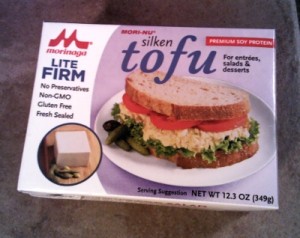If you haven’t cooked with tofu before, it might be intimidating to think about. But it needn’t be! With just a few tips and tricks, you can be well on your way to tasty tofu dishes. With all the tofu we eat – and talk about – on this blog, I want to take a minute and share what I know about cooking the stuff. This is purely from experience over the course of years of vegetarianism; I’ve not had classes or instruction. So, if you know of a better way, or know information I’m lacking, I’d love to learn more! It’s also experience based on my particular supermarket sources, so information in your area may differ.
First, in my area you can buy two primary types of tofu.
One type is silken tofu, which can come in soft, firm, extra firm, or other textures, but will always be great for softer dishes like egg salad, sandwich spreads or pudding. Silken tofu is often shelved at room temperature in small, foil-lined containers that it originally fermented in.
The other kind of tofu is called regular, tub or water-packed tofu, simply packaged as tofu, without the “silken” word used. Regular (water packed) tofu is often kept near the produce section in grocery stores. It may come in a wide variety of textures as well, but all of these will hold up in dishes like stir fry, fajitas, or barbecue. (Some regular tofu now comes sprouted, which behaves and cooks up the same way as nonsprouted regular/tub tofu, but may be easier on some digestive systems).
Most of what we cook here is regular tub tofu, and that’s what I’m going to focus on for the rest of this post (silken tofu can be crumbled straight out of the package or thicker textures of it can be pressed via the process named below.) From here on out, “tofu” means regular tofu.
(THE MOST IMPORTANT PART OF COOKING TOFU HAPPENS BEFORE YOU COOK IT!)
We need to talk about preparing your tofu. As easy as cooking with tofu can be, there is a very important step of preparation that must happen first: we drain the extra liquid. Your tofu has been packed in water, and is saturated with said water. To get the awesome texture you want for these dishes, you’ll want to help the water drain from the tofu first.
You can drain the tofu in one of two ways. Pick ONE of these: PRESSING OR FREEZING:
Pressing Tofu
For this process, you will need:
tofu
paper towels
something weighing a couple of pounds (a pitcher of water will do)
the flatest plates you own (amount of tofu will affect number of plates needed)1) Open the package(s) and pour the extra water out.
2) Slice the tofu any size that will get you closer to your final preferred size, though broader slices will be easier to transport on and off the paper towels.
3) Then, make a “sandwich” with the following layers:
Place a plate on the counter and lay 3-4 layers of folded paper towel on it.
Place tofu slices in a single layer on the paper towels.
Put another layer of 3-4 folded paper towels on top of the tofu.
Put another plate on top.
If necessary for your tofu volume, put another layer of paper towels on top and keep stacking.
End with a plate on top, and place weight on plate.
4) Let sit for at least 20 minutes. Peel tofu carefully off the towels, and tofu is ready for frying, baking, etc.
Pressing is a rather simple process, and can happen while you’re prepping other ingredients. But as often as possible, we just store our tofu in the freezer, and defrost it instead. Freezing removes a bit more water, adds a bit more chewiness to the texture, and assists the tofu in absorbing more of whatever is flavoring it.
Freezing Tofu
For this process, you will need:
tofu
quart or gallon freezer plastic storage bags (NOT regular plastic bags)
freezer space1) When you bring your tofu home from the store, open the tubs and drain the liquid.
2) Gather enough tofu blocks for a full meal, and place them in a single layer in a freezer plastic bag.
3) Label the bags and freeze.
4) When ready to cook with the tofu (preferably they’ve been put in the freezer at least 48 hours before, though 24 hours will do in a pinch), remove from freezer and place entire bag in microwave. Cooking times may very in your microwave; I defrost my tofu 3 blocks at a time, at 60% power for 10 minutes on one side and 10 mintues on the other.
5) LET THE TOFU COOL. Spots may get very hot during defrosting.
6) When cool, squeeze the block gently over a sink, and watch the water pour out.
Once prepped by pressing or freezing, the tofu is ready to cook! We have cooked it into yumminess by: dredging it in breadcrumbs and pan-frying it; dredging it in breadcrumbs and baking it; slathering it in sauce or dressing and baking it; and frying strips, cubes or matchsticks of it in 0.5-1 inch of oil for stir fry, pad thai, fajita dishes and more.
Give it a try and see what your favorite style is! If you got any questions, don’t hesitate to ask!




Leave a Reply